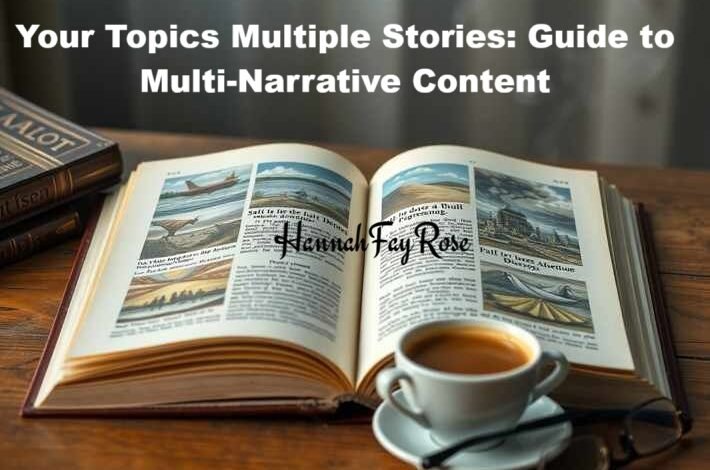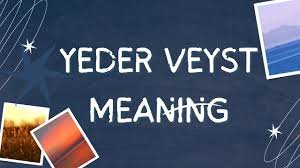Your Topics Multiple Stories: Guide to Multi-Narrative Content

Your Topics Multiple Stories is a flexible content method where one topic is explored through multiple distinct but connected narratives. These stories may show different perspectives, emotions, tones, or formats, yet they all lead back to one core idea. This helps writers, educators, marketers, and platforms build engaging and layered content that appeals to a wide range of people while also boosting SEO visibility.
Whether used in creative writing, educational lessons, brand storytelling, or AI-generated media, this method turns a single idea into a rich and interactive experience that performs across platforms.
Why One Topic Needs More Than One Story
Today’s readers are diverse, fast-moving, and emotionally driven. Some want facts, others look for real-life stories, while many prefer helpful data or emotional inspiration. One flat narrative is no longer enough. A single-topic, multi-story approach lets you combine different story types, creating a complete and satisfying experience.
This approach speaks to both humans and search engines. People connect with stories that match their personality or needs, and Google rewards content that reflects depth, relevance, and semantic variety. Instead of one-size-fits-all, this model gives readers different entry points, all tied to the same subject.
How Multi-Storytelling Improves Understanding and Memory
The brain is built to remember stories. Narratives help us understand, feel, and recall information better than lists of facts. Exploring one topic through multiple lenses—such as emotional, logical, or humorous angles—adds clarity and depth.
Each narrative helps readers see themselves in the topic or understand someone else’s view. This form of content is not only engaging but also builds empathy and long-term retention. For teachers, marketers, or journalists, this makes Your Topics Multiple Stories a smart and practical strategy.
How This Model Supports SEO and Google’s E-E-A-T Guidelines
Modern search engines go beyond keyword matching. Google now looks at relevance, clarity, author trust, and reader value. These traits align with Google’s E-E-A-T model, which focuses on real-world knowledge, professional skill, credibility, and reliability in content.
By sharing multiple stories, your content can highlight real-life experiences, cite expert views, include trusted sources, and reflect consistent author credibility. It naturally allows for semantic variation, covering more search phrases and making your article more likely to appear in featured snippets and rich results.
Creative Uses in Writing, Education, and Digital Media
In writing, one prompt can unlock several stories. For instance, the topic “A Lost Key” might inspire a childhood mystery, a modern security breach, or a memory from old age. These different stories give writers creative freedom and provide more ways to connect with readers.
In education, this strategy is excellent for teaching critical thinking. Teachers can assign one topic and have students write stories with different points of view, settings, or outcomes. This helps build teamwork, comprehension, and ethical reasoning.
In media, it allows content teams to repurpose research and reach more people. A central topic like climate change can become an infographic, blog post, short video, expert interview, or emotional story. All formats link back to one message but speak to different channels.
How AI Makes Multi-Storytelling Easy and Fast
AI tools have made it easier than ever to generate content from one idea. Platforms like MagicSlides.app let users enter a topic and create presentations, comic strips, or summaries from several storylines.
You can ask the tool to show the same topic from a funny, serious, or emotional perspective. Then human writers or designers can fine-tune the result for a specific purpose or voice. This makes brainstorming faster while keeping creativity in your control.
Using Multi-Story Content in Marketing and SEO
In modern marketing, one article per topic is not enough. Brands now need multiple content formats built for different audiences, devices, and sales stages. Multi-story writing allows teams to do just that with less research and more reuse.
A new visitor might see a light or emotional story. A returning user may prefer expert analysis. A business decision-maker will need data, proof, and clarity. Mapping these stories across the buyer’s journey awareness, consideration, and decision—gives users what they need when they need it.
This also allows one story to be turned into a blog post, social carousel, podcast, email, or video. You increase content value, extend its life, and improve search ranking by hitting more related keywords.
How to Structure a Multi-Narrative Article
Start by choosing a topic with emotional depth, practical use, or social impact. Brainstorm how it can be told from at least five different viewpoints or settings. Then write each story as its own short section under a clear heading.
Make sure each part ties back to the main topic. Avoid treating them like separate articles. Use linking sentences to guide readers from one idea to the next. Your format should include short paragraphs, logical order, and clear summaries to improve user experience and SEO results.
Each story should have its own purpose but also contribute to the bigger picture. This allows readers to jump in anywhere, while keeping the overall structure connected.
Examples from Journalism and History
News coverage often uses multiple voices to give a full picture. For example, a protest can be covered from the view of a demonstrator, a reporter, a police officer, and a policy expert. Each story adds value and builds trust.
In history, events like World War II are more deeply understood through multi-narrative accounts. While general textbooks focus on generals and battles, newer studies include stories of medics, civilians, refugees, and resistance fighters. These stories give us a more honest and layered understanding.
Today, AI-powered apps like Google News and Flipboard use this same logic. They show users multiple stories around a topic, tailored by behavior, interest, and real-time data.
Writing Multi-Story Content on Your Own
To write your own article using this method, start with a clear main idea. Then, break it into different story types such as:
Personal story, Expert opinion, Data insight, Ethical question, Future trend, or Cultural viewpoint.
Write each as a short section. Keep your tone friendly, clear, and emotional when needed. At the end of each story, bring it back to the main point, showing how it fits the bigger message.
Let the stories vary in style. One story can carry a gentle tone, while another can offer deep reflection, allowing different emotional layers to emerge. Allow room for contrast. Real stories often don’t agree and that’s what makes them powerful.
Keep your paragraphs short and clear. Use simple sentences, and never let one narrative dominate the others. This makes your writing feel fair, complete, and emotionally honest.
Challenges and Solutions for Using Multiple Stories
Some topics might not have enough depth for five or six strong narratives. Make sure your main subject has meaning, emotional value, or practical impact. If the topic feels too narrow, consider expanding it or selecting a subject that connects with more people.
Keeping the article consistent is another challenge. If your stories feel random, the reader might get confused. Use summary sentences to connect each story and repeat your main idea throughout to hold everything together.
Avoid letting one tone or voice dominate. Let each perspective get equal care. Show balance and keep your writing open-minded. This builds trust and encourages reflection.
Also, don’t overwhelm readers. Keep each story focused, short, and useful. Readers prefer a few deep insights over many shallow ones.
Why This Approach Matters Today
We live in a fast, noisy world. Readers are tired of one-sided views and empty headlines. They want content that feels real, reflects complexity, and gives them space to think.
Your Topics Multiple Stories gives readers just that. It lets writers speak to different minds and emotions, showing the full picture, not just the easy one.
This method also prepares content for voice search, AI feeds, and smart devices, which now deliver layered and context-aware stories. When your content is built with range and relevance, it lasts longer, performs better, and reaches more people.
Conclusion
Your Topics Multiple Stories is not just a writing trick. This approach mirrors real user behavior by aligning with how individuals explore, process, and respond to information online. It invites diversity, delivers depth, and supports both emotional and digital intelligence.
When you include real-life stories, expert input, structured insights, and relatable tone, your content becomes more powerful, more trusted, and more valuable. You meet search engine standards and reader expectations in one complete experience.
This method allows writers, teachers, marketers, and platforms to turn one simple idea into a world of stories, each one adding meaning and connection. Done right, Your Topics Multiple Stories becomes a timeless strategy that helps ideas grow, inspire, and reach new heights.
Frequently Asked Questions ( FAQs ) What does “Your Topics Multiple Stories” mean?
“Your Topics Multiple Stories” means exploring one topic through several different stories. Each story can reflect a new angle, emotion, or point of view, while still being connected to the main idea.
Why is it helpful to tell multiple stories on one topic?
Telling multiple stories helps reach more readers. It offers deeper understanding, emotional connection, and shows different sides of the same topic. This makes your content more engaging and complete.
How does Your Topics Multiple Stories improve SEO?
This method improves SEO by adding depth, relevance, and variety. It includes more related keywords, answers different search intents, and helps rank for featured snippets and rich results.
What are examples of topics that work well with multiple stories?
Examples include:
- A life lesson learned from a mistake
- Climate change effects in different communities
- One invention seen through history, science, and society
- The same event told by different people
These topics allow rich, layered storytelling.
Who can use the Your Topics Multiple Stories approach?
Anyone who creates content can use it. This includes teachers, writers, students, marketers, bloggers, journalists, and even app developers working with AI and personalized feeds.
How do I write a multi-story article?
Start with a main topic. Then write 3–6 short stories or sections, each showing a different angle. Use clear headings, short paragraphs, and connect every part back to the main idea.
Can AI tools help create multiple stories on a topic?
Yes, AI tools like MagicSlides or ChatGPT can help you brainstorm and generate different stories quickly. They support content ideas, tone changes, summaries, and layout suggestions.
How does this method support Google’s E-E-A-T standards?
It supports Experience by including real stories, Expertise by adding expert input, Authoritativeness through strong sources, and Trustworthiness with transparent structure and value.
What is the difference between a single-story and multi-story article?
A single-story article tells one version of a topic. A multi-story article shares different viewpoints, emotions, or formats, making it more flexible, useful, and relatable.
Why is Your Topics Multiple Stories important in 2025 and beyond?
This method matches how readers think, search, and feel today. It helps you stand out, perform better on search engines, and connect more deeply with your audience across platforms and formats.





